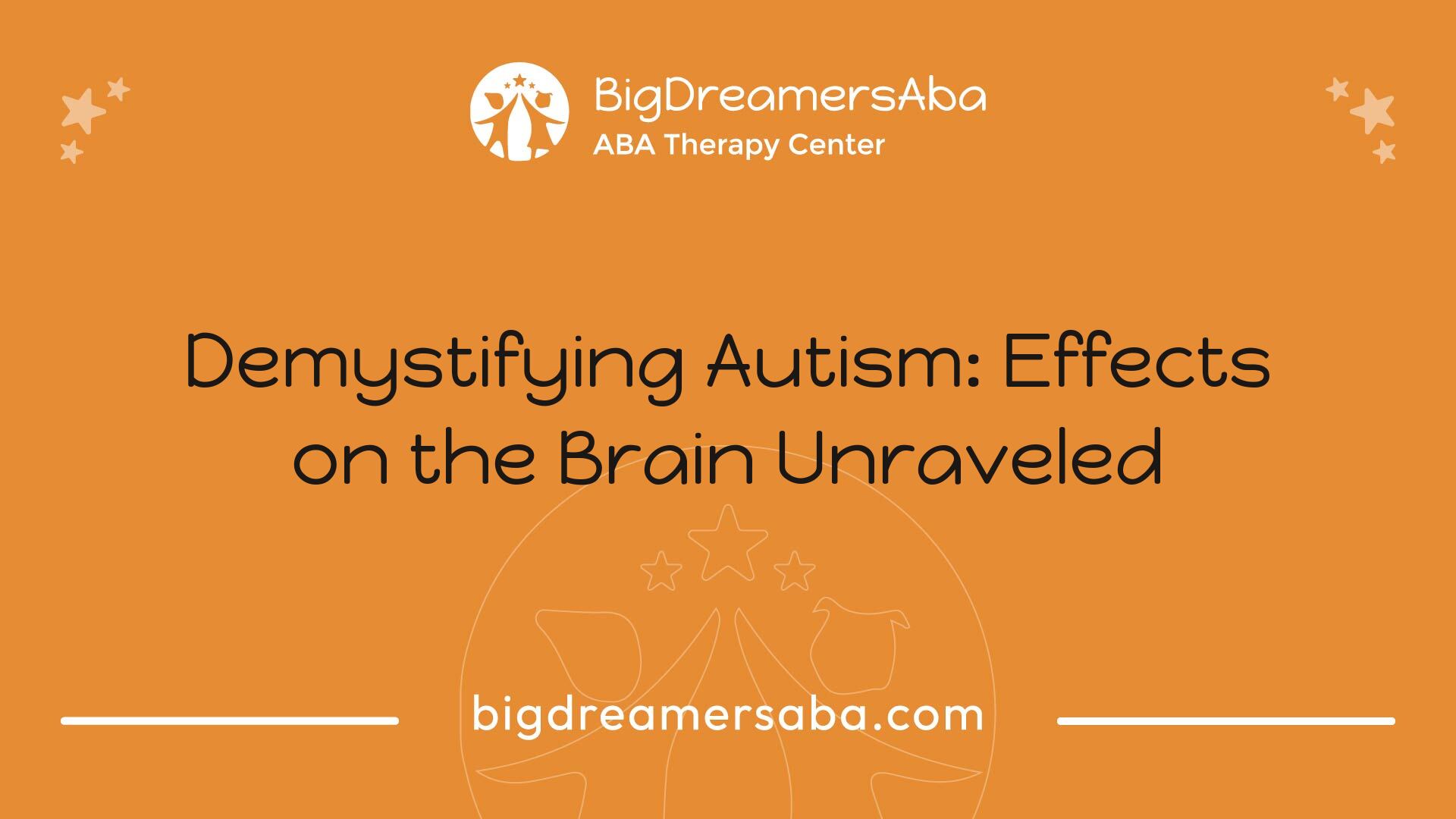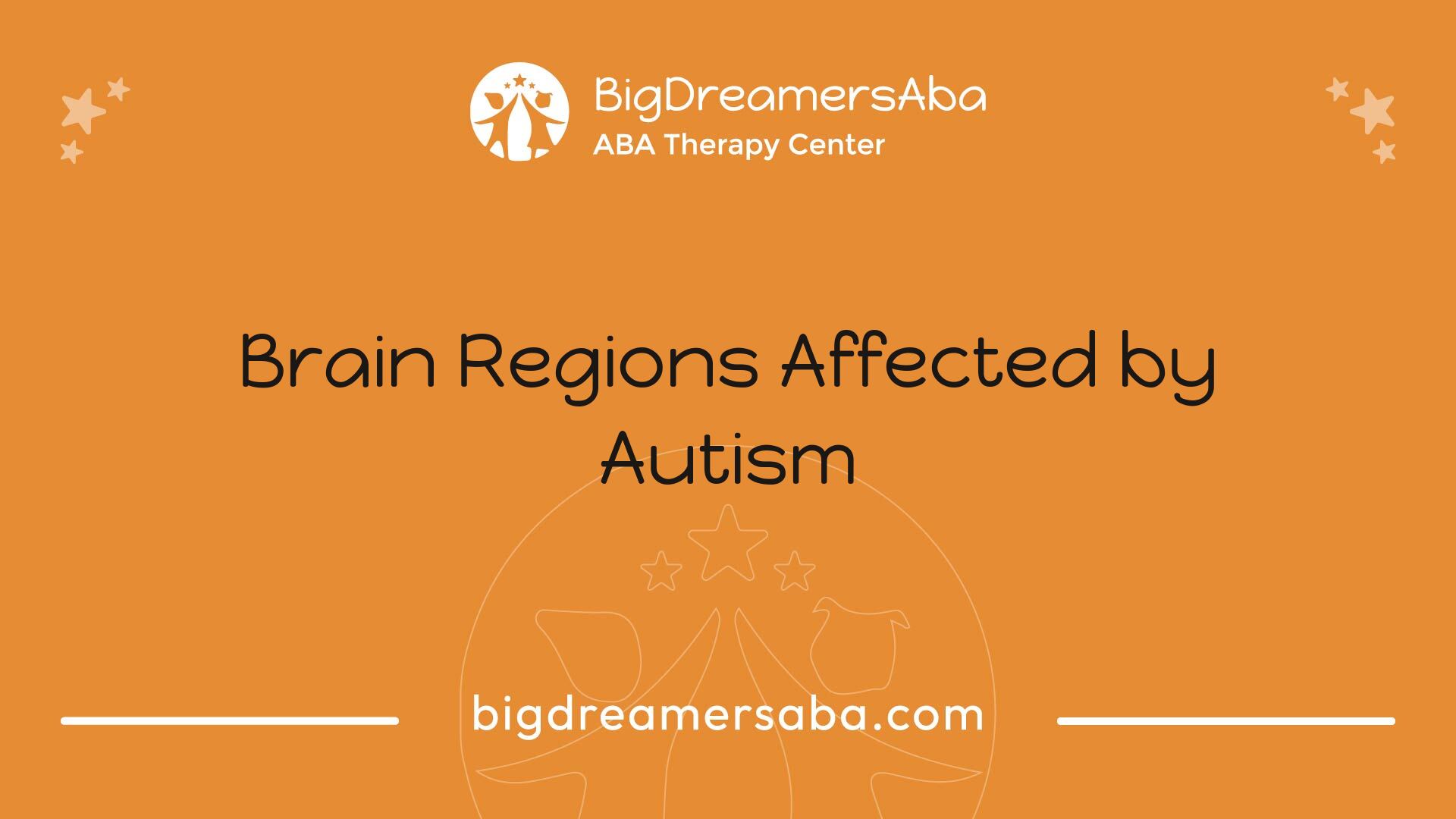Demystifying Autism: Effects on the Brain Unraveled
Explore autism's effects on the brain, uncovering key neurological impacts and the latest research insights.


Understanding Autism and the Brain
Abnormal Brain Overgrowth in Autism
Research indicates that children with autism experience abnormal brain overgrowth during the first two years of life. This overgrowth primarily affects cerebral, cerebellar, and limbic structures linked to higher-order cognitive, social, emotional, and language functions. The most significant growth occurs early in development, followed by a phase of abnormally slow or stunted growth. This pattern can lead to dysfunctional connectivity in the brain, which may contribute to the emergence of autistic behaviors [1].
The following table summarizes the key brain structures impacted by this growth pattern:
Brain StructureRole in FunctionCerebral CortexHigher-order cognitive functions, social skills, language processingCerebellumMotor control, coordination, and emotional regulationLimbic SystemEmotion and behavior regulation, memory formation
Understanding these changes provides insight into how autism's effects on the brain may manifest in behavior and development.
Sensory Aspects in Autism
Sensory issues are prevalent among individuals with autism and are included in the diagnostic criteria for autism spectrum disorder. Sensory sensitivities vary greatly among individuals, with each person experiencing unique sensory profiles. Research shows that more than 96% of children with autism report hyper and hypo-sensitivities across various sensory domains.
Moreover, many people with autism engage in stimming behaviors as a way of sensory seeking to keep their sensory systems in balance. Repetitive movements or sounds can help calm individuals, reduce stress, or block out uncomfortable sensory stimuli.
Another aspect of autism is the difficulty that some autistic individuals face in situations requiring multi-sensory integration (MSI). They may perform poorly when integrating information across multiple sensory modalities due to challenges in processing inputs effectively. This inability can add complexity to their interaction with the environment, influencing their overall experiences [2].
Understanding these sensory aspects is crucial for providing supportive environments and tailored interventions for individuals with autism. For those interested in learning more about the specific functions of the autistic brain, resources such as how do autistic brains work? provide valuable information.
Neurological Impacts of Autism

Autism spectrum disorder (ASD) affects not just behavior but also the neurological functioning of the brain. Research indicates that there are significant differences in brain connectivity, structure, and genetic influences that impact individuals on the autism spectrum.
Brain Connectivity and Function
Studies show that individuals with autism display unique patterns of brain connectivity. Specifically, ASD brains exhibit short-range over-connectivity paired with long-range under-connectivity [4]. This abnormal connectivity affects the synchronization between different brain regions, influencing tasks that require social skills and complex motor functions.
Type of ConnectivityDescriptionShort-range Over-connectivityIncreased connections within local brain regions, which may enhance local processing.Long-range Under-connectivityDecreased connections between distant brain regions, impacting social functions and complex behaviors.
Brain Structure Variances
Research has identified several structural differences in the brains of individuals with autism. Genetic studies point to specific risk genes, such as NL3, MECP2, and ITGB3, which affect brain morphology. Mutations in these genes have been associated with variations in brain volume across different regions, indicating their influence on brain development [5].
Brain RegionImpactFrontal CortexTypically associated with social cognition and decision-making, often shows structural variances in autistic individuals.Temporal CortexInvolved in language processing and memory, may exhibit alterations in volume and connectivity.CerebellumPlays a role in motor function and coordination; variances may affect physical actions and social skills.
Genetic Influences on Brain Development
Genetic factors play a significant role in the development of autism and its effects on the brain. Variants in genes such as NRXN1, OXTR, MET, and AVPR1A have been linked to alterations in brain connectivity and structure, particularly in regions significant for social and emotional processing [5].
Monogenic risk factors, including conditions like fragile X syndrome and Rett syndrome, also share connections with common brain regions associated with social cognition and language abilities. Approximately 15% of autism cases are linked to major effect genes like NLGN4, NRXN1, and SHANK3, although these variants are rare among the broader population of children diagnosed with ASD.
Understanding these neurological impacts is essential for developing effective interventions and supportive care aimed at enhancing the quality of life for individuals with autism. For further insights into how autistic brains operate, refer to our detailed article on how do autistic brains work?.
Brain Regions Affected by Autism

Autism significantly impacts various brain regions, leading to observable differences in structure and function. Understanding how these areas are affected can provide insights into the challenges faced by individuals with autism.
Cerebellum and Motor Skills
The cerebellum is crucial for coordinating movements and balance. Research indicates that individuals with autism often exhibit abnormalities in the size, shape, and function of the cerebellum, which can lead to difficulties with motor skills, balance, and coordination. Studies have shown that autistic individuals have a significantly smaller cerebellum compared to those without the condition.
A meta-analysis of 17 imaging studies confirmed that there is reduced brain tissue in specific regions of the cerebellum for those with autism. This structure's role extends beyond merely coordinating movements; it also influences cognitive and social interactions. Autistic individuals may struggle with these facets due to cerebellar abnormalities.
Problem AreasEffectsMotor SkillsDifficulty with coordinationBalanceImpaired physical stabilityCognitionChallenges in processing informationSocial InteractionStruggles in engaging with others
Hippocampus and Amygdala Variances
The hippocampus and amygdala are essential regions for memory and emotions. Variations in these areas among autistic individuals can contribute to the characteristic features of autism. While research specifically detailing the differences in these structures in autism is ongoing, it is understood that changes here can affect emotional regulation and social behavior.
Individuals with autism often face challenges in processing and responding appropriately to social stimuli, which is partially attributed to hippocampal and amygdala variances. These complexities can lead to difficulties in forming relationships and managing emotions effectively.
Brain RegionFunctionAutism ImpactHippocampusMemory formationPotential memory processing issuesAmygdalaEmotion regulationHeightened or blunted emotional responses
Corpus Callosum and Communication
The corpus callosum connects the left and right hemispheres of the brain, facilitating communication between them. Research indicates that individuals with autism typically have a larger than average corpus callosum. This enlargement may enhance interhemispheric communication, which can contribute to the problem-solving abilities and unique strengths that some individuals with autism display [7].
The size of the corpus callosum could play a role in how an individual processes information, possibly affecting communication styles and social interactions. Different communication strategies may emerge due to these unique brain configurations.
AspectConsiderationCommunicationEnhanced interhemispheric connectivityProblem-SolvingUnique cognitive strengthsSocial InteractionVariability in interaction approaches
These insights into how autism affects specific brain regions provide a clearer understanding of the condition and its complexities. For more in-depth information about how autistic brains function, visit how do autistic brains work?.
Brain Imaging and Early Detection
The early detection of autism is crucial for effective intervention and support. By utilizing advanced brain imaging techniques, researchers can identify specific changes in brain structure and function associated with Autism Spectrum Disorder (ASD).
Early Brain Changes in Autism
Research has indicated that autism-specific features can be detected as early as 6 months of age. Studies demonstrate that significant brain and behavior changes linked to autism arise within the first 2 years of life. This emphasizes the developmental nature of ASD and the importance of early detection in facilitating timely support [8].
Early brain imaging studies using techniques such as diffusion tensor imaging (DTI) tractography have revealed abnormalities in the white matter structure in infants diagnosed with ASD later on. These structural alterations may serve as potential biological markers for the early diagnosis of the condition.
Age (Months)Observed Changes6Early brain changes indicative of ASD detected via DTI24Correlation with functional connectivity and diagnosis of ASD
Predictive Brain Imaging Techniques
Functional connectivity MRI (fcMRI) has shown promise in predicting autism diagnoses in infants. Scans performed on infants as young as 6 months old demonstrated the capability to accurately foresee which infants would later receive an ASD diagnosis at 24 months. This highlights the potential for utilizing functional brain connectivity for early detection.
Early brain imaging technologies not only reveal physical changes but can also provide insights into how the brain is wired. These advancements propose a method for presymptomatic prediction of ASD, allowing for interventions tailored to individual needs.
Additionally, age-related differences in gene expression related to synaptic function and immune response have been identified in autistic brains compared to neurotypical ones. Understanding these changes can further inform predictive techniques and interventions [9].
The development of these imaging technologies offers hopeful avenues for early identification of autism, enabling families and healthcare professionals to implement supportive strategies from a very young age. For more insights into how autistic brains function, explore our article on how do autistic brains work?.
Gene Expression and Brain Ageing
Understanding gene expression in the context of autism provides valuable insights into how the condition affects the brain over time. This includes examining differences in mRNA and the immune response that may impact overall brain health.
mRNA Differences in Autistic Brains
Research indicates that autistic individuals exhibit significant differences in the expression of mRNA compared to neurotypical individuals. Specifically, studies have shown that downregulated genes in autistic brains are linked to brain connectivity. This suggests possible inefficiencies in neuronal communication and faster brain aging in these individuals [9].
In particular, autistic individuals have been found to produce higher levels of mRNA for heat-shock proteins. This may indicate potential immune dysfunction that could worsen with age. The implications of these mRNA alterations include increased neuronal hyperactivity, which could be linked to the challenges faced by those with autism.
mRNA ChangeObservationDownregulated GenesLink to brain connectivity issuesIncreased Heat-Shock ProteinsSuggest immune dysfunctionImplicationsFaster brain aging and neuronal hyperactivity
Immune Response and Inflammation
In addition to mRNA differences, immune responses and inflammation play a critical role in understanding autism's effects on the brain. Studies have identified age-related differences in gene expression related to synaptic function, immunity, and inflammation pathways in autistic brains compared to their neurotypical counterparts.
These findings suggest that the immune system may be overactive or dysfunctional in autistic individuals, potentially leading to inflammatory processes that can influence brain function over time [9]. As research continues, understanding these pathways may provide deeper insights into the biological basis of autism and help develop more targeted interventions.
To learn more about how the autistic brain works, visit our article on how do autistic brains work?.
Age-Related Brain Variances
Understanding the age-related changes in the brain of individuals with autism can provide valuable insights into how autism's effects on the brain evolve over time. Research has indicated significant differences in gene expression and neuronal activity that may impact individuals as they age.
Gene Expression Changes Over Time
A pivotal study highlighted age-related variations in gene expression related to synaptic function, immunity, and inflammation in autistic brains versus neurotypical brains. It identified a total of 194 significantly different genes in autistic brains, with 143 genes displaying increased mRNA levels and 51 genes exhibiting decreased mRNA levels compared to neurotypical counterparts [9].
The alterations in gene expression are particularly relevant for understanding the biological basis of autism. Notable findings include:
Gene Expression ChangeFunctionImplicationIncreased mRNA for heat-shock proteinsStress and immune responseSuggests potential immune dysfunction that could worsen with ageDecreased GABA synthesisInhibitory neurotransmissionMay contribute to neuronal hyperactivity in autistic individuals over time
These findings suggest that various pathways may influence aging and neuronal health in autistic individuals, potentially increasing the risk for cognitive decline and neurodegenerative conditions.
Impact on Neuronal Activity
In addition to gene expression changes, neuronal activity in autistic individuals appears to be affected as they age. The alterations in gene expression could lead to inefficiencies in neuronal communication, particularly within regions of the brain responsible for connectivity. The study also indicated that these changes might accelerate brain aging processes in autism.
Insulin signaling was found to be altered at the molecular level in neurons, which may have broader implications for metabolic processes and neuronal health. This disruption could be related to an increased risk of neurodegenerative diseases, further complicating the quality of life for individuals with autism as they grow older.
Overall, the understanding of how gene expression and neuronal activity change with age can offer valuable insights into the complexities of autism and its long-term effects. For more information on how brain function relates to autism, refer to our article on how do autistic brains work?.
References
[2]:
[3]:
[4]:
[5]:
[6]:
[7]:
[8]:
[9]:
Recent articles

ABA Techniques for Picky Eaters: Building Better Habits

How Social School Support Makes School Transitions Easier for Children
